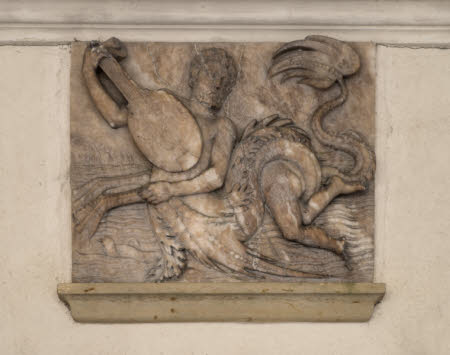A fish-centaur
Category
Art / Sculpture
Date
1601 - 1699
Materials
Alabaster
Measurements
530 x 610 mm
Place of origin
England
Order this imageCollection
Knole, Kent
NT 130073
Summary
Alabaster, relief panel showing an ichthyocentaur (fish-centaur) playing a lute with a woman ensnared in its tail, English, 17th century. The ichthyocentaur (fish-centaur) is in a sea or river. He ensnares a female figure who has been captivated by his lute playing. The centaur is part man part fish, with the clawed forefeet of a bird. Rushes are visible in the background at left, with the head of a bird rising from the water in the foreground at left.
Full description
The motif originates from a cartouche designed by the Flemish artist Jakob Floris the Elder (1524-1581). Published in Antwerp in 1564, Floris' 'Veelderhande cierlijcke Compertementen profitelijck' was a book of designs used for inspiration and copying by painters, goldsmiths, sculptors and masons. Designs from this publication appeared in England from 1576, in cartouches for Christopher Saxton’s maps of Cornwall (1576) and Lancaster (1577) and in the interiors of country houses, predominantly in the south west of England. The Knole panel is one of four sculptural derivations of cartouches in the 'Veelderhande cierlijcke Compertementen profitelijck'. Anthony Wells-Cole has identified others in plasterwork and overmantels at Buckland Abbey and Newton Abbot, Devon, and Stockton House, Wiltshire (Wells-Cole 1997, p.54). It may be that the Knole panel, isolated and reset in the loggia of the Stone Court, was also part of a larger interior scheme, now broken up.Derivations and direct copies from Floris’ later publication 'Compartimentorum quod vocant multiplex genus lepidissimis historumque fabellis ornatum' (1566) also appear in plasterwork, screens, and chimney pieces across the West Country from the latter part of the sixteenth century into the seventeenth. The success of Floris’ engraved designs amongst English craftsmen was owed, according to Wells-Cole, to their translatability: they ‘embodied the essence of the Antwerp Mannerist style without being impossibly difficult to adapt’ (Wells Cole 1997, p.56).Alice Rylance-WatsonSeptember 2018
Credit line
Knole, The Sackville Collection
References
Wells-Cole 1997 Anthony Wells-Cole, Art and Decoration in Elizabethan and Jacobean England: the influence of continental prints, 1558-1625, New Haven & London 1997, pp.54-6

